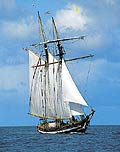| |
|
A SHORT HISTORY
THE AMERINDIAN PEOPLES
Arawaks and Caribs
Over the centuries a diverse mixture of people from the South American continent migrated to the Antilles. Several hundred years ago the Arawaks occupied the whole archipelago. A
generally peace-loving people, most of their lives were spent growing food, fishing and making pottery.
 This easy-going life was brutally interrupted around the 12th century by fearsome tribes of Caribs (or Kalinas), also from South America. This easy-going life was brutally interrupted around the 12th century by fearsome tribes of Caribs (or Kalinas), also from South America.
The new conquerors were redoubtable warriors and cannibals to boot. (The Indian name ‘Kalinas’, which means ferocious people, has given us, via Spanish, the word cannibal.)
After this warlike interlude, all might have gone on as before in this best of Caribbean worlds if, in distant Europe, hardy sailors hadn’t wished to discover where the ends of the Earth lay.
Discovered by Columbus
Christopher Columbus, a native of Genoa, proposed to the Spanish monarchs, Isabella of Castile and John of Aragon, that he could reach
the fabled ‘Spice Route’ by going westabout.
On the 12 October 1492 the three ships of the small fleet (the Pinta, the Nina and the Santa Maria) made landfall on an island in the Bahamas, which the locals called Guanahani. In thanks, Columbus baptised it St Salvador (St Saviour).
After that
Columbus found Cuba and Hispaniola and declared them Spanish territory without any thought for the last Arawaks, fleeing from their Carib enemies, who had found a final refuge there.
Over three successive further voyages (1493, 1498 and 1502), Christopher Columbus discovered almost all the Antilles and named them either as fancy took him or according to the liturgy of the times.
|
|
|
|
Conquest and filibusters
No conquest is philanthropic, and it was the thirst for gold that drove Spanish colonisation. Ignoring the Lesser Antilles, the Spaniards occupied the larger islands where gold at least existed, if not in abundance.

Their greed worked against them because by the 16th century the English, French and Dutch had established themselves in the smaller islands in order to intercept the rich treasure fleets on their return voyages to Spain.
 This is the origin of the romantic figures of the filibusters whose ships, lying in ambush in the maze of islands, fell upon the Spanish on every occasion that presented itself. This is the origin of the romantic figures of the filibusters whose ships, lying in ambush in the maze of islands, fell upon the Spanish on every occasion that presented itself.
Depending on the ups and downs of the alliances and wars which raged in Europe, the French and English royal fleets shared in the pillage.
 Spain was soon unable to ensure its monopoly over the West Indies and from the 17th century on, it definitively abandoned all its claims on the Lesser Antilles. Spain was soon unable to ensure its monopoly over the West Indies and from the 17th century on, it definitively abandoned all its claims on the Lesser Antilles.
The major targets of plunder, gold and treasure from the first days of conquest soon dried up. The filibusters died out of their own accord and the pirates who hadn’t been hanged or killed in combat joined them.
|
|
|

